Japanese researchers want to protect astronauts’ health on the moon and Mars by building space habitats that spin to create artificial gravity — but pulling it off will be a huge, multi-generational undertaking.
The challenge: More than 50 years of space exploration has taught us that microgravity can wreak havoc on astronauts’ bodies, causing weak bones, muscle loss, and vision problems.
Gravity isn’t as weak on the moon and Mars as it is in space, but it is a lot weaker than on Earth (one-sixth and one-third the strength, respectively). Before we send people to live in either location long term, we need to figure out how to protect their health.
Centrifugal force will allow people to walk on the interior walls of the cones just like they would on Earth’s surface.
Take a spin: Researchers from Kyoto University and Japanese construction company Kajima Corp. have announced plans to develop and build living facilities with artificial gravity on the moon and Mars.
Dubbed Luna Glass and Mars Glass, each facility is shaped like a huge hollow cone more than 1,300 feet tall — almost as tall as the Empire State Building. As the cone spins, centrifugal force will push anything inside them toward the interior walls — if you’ve ridden the Rotor or the Gravitron at an amusement park, the concept is similar.
By getting the spinning speed just right (one rotation every 20 seconds), the researchers believe they’ll be able to match this centrifugal force to the force of gravity on Earth. People inside the cone will then be able to walk on the interior walls just like they would on Earth’s surface.
Wait, there’s more: Creating artificial gravity on the moon and Mars is just the first part of the Japanese team’s plan.
They also want to build “mini-core biomes” that mimic Earth’s water and forest ecosystems in Luna Glass and Mars Glass and establish a transportation system with a “space train” that lets people enjoy artificial gravity while traveling between Earth, Mars, and the moon.
Swinging big, thinking long-term: The researchers aim to construct a prototype of Luna Glass on the moon by 2050, but said in a July 5 news conference that they expect it’ll take at least 100 years to bring their full plan to fruition.
Even that timeline may be ambitious, given that humans haven’t even been to Mars at all yet and have no experience creating any kind of space habitat beyond the fringes of Earth’s atmosphere — let alone ones with artificial gravity.
Still, reduced gravity is a big health risk, and we need to figure out some way to solve this obstacle if we ever want to live off-world. Even if giant spinning cones aren’t the short-term solution we’re looking for, research like this could point us in the right direction for constructing livable space colonies.
We’d love to hear from you! If you have a comment about this article or if you have a tip for a future Freethink story, please email us at tips@freethink.com.
